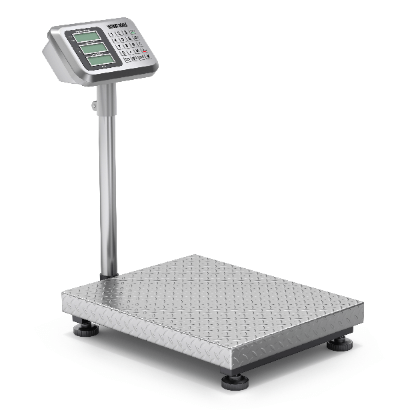What Is a Digital Scale?
 Digital Scales are mainly used to measure the mass of objects weighing from 30 kg to 3,000 kg.
Digital Scales are mainly used to measure the mass of objects weighing from 30 kg to 3,000 kg.
Generally, they are high-precision scales with an accuracy of 1/3,000 to 1/6,000 (scale interval/weighing scale). A platform scale is a weighing instrument in which the object to be weighed is placed on the platform and the mass is measured by using the sinking of the platform.
From the viewpoint of appearance, they can be classified into two types: an integrated type in which the “indicator” for operation and display and the “platform” on which the object to be weighed are integrated, and a separate type in which the indicator is separated from the platform.
From the viewpoint of internal structure, they can be classified into the “electromagnetic type,” which detects the load electrically and adjusts the electromagnetic force to make the weighing platform level, and the “load cell type,” which detects an electric signal proportional to the load.
Uses of Digital Scales
Digital Scales are used for a wide range of applications, from weighing goods and agricultural and marine products to weighing trucks and other vehicles. There are many types, ranging from small to large, depending on the application, such as those embedded in the ground for truck weighing and those that can be washed in water for livestock weighing.
When forklifts are used in factories, pallets and weighing platforms are combined into one unit (Integrated Digital Scale), and the weighed items may be moved as they are. In this case, an explosion-proof structure is used.
Principle of Digital Scale
The principle of Digital Scales differs depending on the type.
1. Load Cell Type Digital Scale
A load cell is a transducer that converts a load into electrons. An electrical resistance strain gauge called a strain gauge is attached to a metal body that generates strain when subjected to external force, and the change in resistance is measured.
The principle is the same as that of a spring gauge, since it uses the elasticity of the metal. The mass cannot be determined directly because the weight causes the strain. Therefore, by calibrating the displayed value with a weight, the displayed value can be treated as a mass for convenience. The accuracy is much higher than that of a spring scale.
2. Electromagnetic Digital Scale
The electromagnetic type is also called “zero balance type” or “force balance type”. The object to be weighed is placed on one side of the device, which is structured like a balance.
The other side is equipped with a force coil, to which an electric current is applied to generate an electromagnetic force so that the balances balance each other. The principle is that the weight is quantified by measuring the current that flows through the force coil when the balances are balanced.
In the electromagnetic method, since the strength of the electromagnetic force to be balanced is related to the weight, it is not possible to determine the mass by itself. Therefore, the mass can be displayed by calibrating the balance with a weight of known mass in advance and calibrating the mass on the balance to the electromagnetic force to be balanced.
In this way, it can be said that the function of a balance scale is realized with the electromagnetic force as a mediator. Compared to load cell strain gages, the mechanical structure of a balance is more delicate, making it suitable for weighing lighter and smaller objects.
Other Information on Digital Scales
1. Types and Principles of Weighing Instruments
There are two types of scales: spring scales, which use the elasticity of a spring to measure weight (the amount of universal gravitation), and balance scales, which use the balance to measure mass (the original amount of a substance). A spring balance weighs an object by measuring the extension of a spring using the fact that the extension of a spring is proportional to the weight of the object (Hooke’s law).
A balance scale uses a weight of known mass to weigh an object and a weight together (creating a state in which the weights are equal), and determines the mass of the object from the mass of the weight.
Currently, the most common types of Digital Scales are the load cell type and the electromagnetic type.
2. Calibration
Calibration is essential for digital balance scales. With mechanical balances, the weights are always used, so there is no need to be aware of calibration. Since the weight and the item to be weighed are placed in the same environment, it can be said that all environmental factors cancel each other out.
On the other hand, a digital balance does not use weights when weighing, so it must be calibrated in advance using weights in the environment at the time of weighing.
Another factor is that gravity varies slightly from region to region. Due to the centrifugal force of the earth’s rotation, gravity is slightly lower near the equator. Specifically, it is 0.5% smaller than at the North and South Poles.
This means that even if a platform scale is manufactured, adjusted, and shipped, the displayed value will not be correct unless it is calibrated.
As a practical environmental factor, atmospheric pressure also has an effect. The object to be weighed and the weighing pan are also subject to the buoyancy of air. Therefore, depending on the desired accuracy, it may be necessary to calibrate the scale daily (considering that the weather changes and the atmospheric pressure changes over the course of the day).